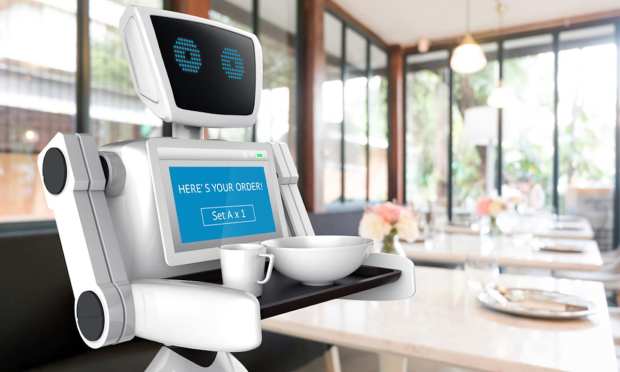Restaurant Robotics Shift to Customer-Facing Roles

As labor challenges persist indefinitely, restaurants are looking for solutions that automate every step of the process. While self-service kiosks can remove the need for waitstaff for the quick-service occasion, where the consumer wants to grab their food and go, some tech companies are looking to bring robotics into more traditionally customer-service-oriented roles. On Tuesday (Jan. 4), Bear Robotics, the creator of service robots being piloted by Chili’s and Denny’s, among others, announced its partnership with polymer company Covestro to create hospitality robots that could withstand the wear and tear of the job.
Moreover, this week, tech startup GKI group is showcasing its Cecelia conversational artificial intelligence (AI) robotic bartender at CES 2022. An animated avatar speaks to the customer, accepting order by voice, while the liquid-loaded machine mixes and dispenses the drink, reportedly able to fulfill 120 orders within an hour.
These technologies, which put automation right in consumers’ line of sight, take a very different approach than many other restaurant robotics startups, which focus on the back-of-house experience, framing their technologies as a way for restaurants to free up their staff for customer-facing roles. However, some in the field — especially those with a front-of-house robotic solution to sell — argue that consumers no longer expect that face-to-face interaction.
“It’s a dramatic transition,” Rajat Suri, founder and CEO of restaurant voice, vision and touch technology company Presto, told Karen Webster in an interview. “This industry has been old-school for many, many years. It’s been very analog, very much ‘we do service the old-fashioned way.’ That’s kind of always been seen as a perk in the industry, and technology as kind of the enemy. Now it’s going through this rapid transition where it’s like technology is the only way to operate.”
Related news: Why Robots Will Staff the Restaurant of the Future
Consumers have reacted negatively on social media to some early forays into robotic waitstaff, but this anecdotal sample gives little sense of how these innovations will affect customers’ experiences on a wider scale.
Of course, automation is also processing at a rapid clip for other tasks necessary to the functioning of the restaurant industry as well. On Wednesday (Jan. 5), Presto’s Ottonomy robotics company revealed to the CES audience its Ottobots, autonomous delivery robots meant to not just bring foods from restaurants to consumers’ doors, as other similar models do, but also to work in indoor spaces. With its launch at CVG Airport, Cincinnati, it will be the first robot to make in-airport deliveries.
“The demand [for delivery] is rising — people want things faster, and they want it cheaper,” Ali Kashani, co-founder and CEO of Postmates spinoff Serve Robotics, told PYMNTS in an interview. “It’s just not sustainable. The way we are doing the deliveries today, relying on one human being having to move one burrito to its final destination … It’s just not going to scale. It’s not good for the cities. It’s not good for the environment, and it’s not good for the restaurants and merchants. I think it’s a perfect time for the robots to step in and help with this problem.”
